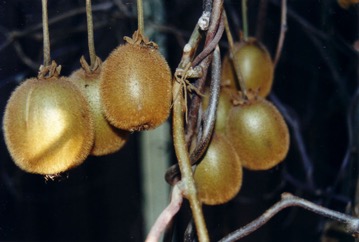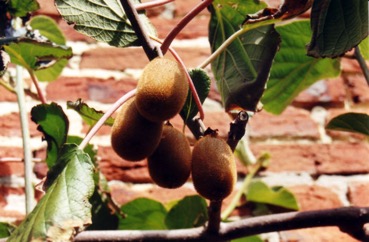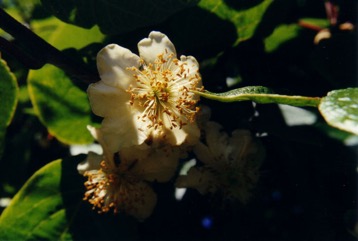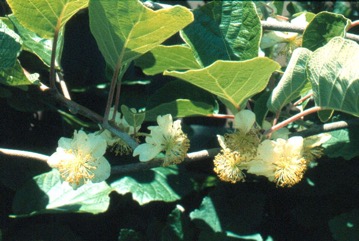Chinese gooseberry, Kiwifruit

It is a temperate plant. It is a plant derived in cultivation from Actinidia chinensis, it is not known in a truly wild situation. Plants requires a 6-8 month frost-free growing season. They are hardy to about -12°C when fully dormant but young growth is very subject to damage by late frosts, being killed back at -2°C. Plants also require a winter chilling of 600 - 1100 hours below 7°C and a long warm summer to ripen the fruit. Temperatures above 35°C and low humidity scorch leaves. Plants prefer a sound loamy acid soil, and dislike alkaline soils becoming chlorotic at pH 6 or higher. They tolerates a pH in the range 5.5 to 7.3. It suits hardiness zones 7-10.
Also known as:
Delicious donkey fruit, Kivi, Meiwei Mihoutao
Synonyms
- Actinidia chinensis of gardens
- Actinidea chinensis var. deliciosa (A. Chev.) A. Chev.
- Actinidia chinensis var. hispida C. F. Liang
- Actinidia latifolia var. deliciosa A. Chev.
Edible Portion
- Fruit, Vegetable
Where does Chinese gooseberry grow?
Found in: Australia, Brazil, Britain, Canada, China, Europe, New Zealand, North America, Pacific, Slovenia, South America, Switzerland, Tasmania, Uruguay
Notes: Rich in vitamin C, fresh fruit containing 100 - 420 mg of vitamin C per 100 g and 8 - 14% carbohydrate. There are 40-60 Actinidia species. The Actinidiaceae are a mainly tropical family.
Growing Chinese gooseberry, Kiwifruit
Cultivation: Male and female plants must usually be grown if seed is required, one male to five or six females is normally adequate. Plants can be grown from softwood cuttings. Cuttings 1 cm thick and 20-30 cm long are suitable. They are taken when well matured and dormant. They can be grown from seed but these take 7 years to fruit. Fruit grow on current season's growth, so regular pruning is important. A spacing of 4-6 m is suitable. One male plant near each nine female plants is a suitable ratio.
Edible Uses: The fruit are eaten raw or cooked.
Production: Vines produce after 4-5 years. Yields of 8 - 30 tonnes per hectare are possible. One plant can produce 50-100 kg of fruit. Fruit can be kept at room temperature for up to 8 weeks.
Nutrition Info
per 100g edible portion| Edible Part | Energy (kcal) | Protein (g) | Iron (mg) | Vitamin A (ug) | Vitamin c (mg) | Zinc (mg) | % Water |
|---|---|---|---|---|---|---|---|
| Fruit - raw | 61 | 1 | 0.4 | 18 | 98 | 0.2 | 83.1 |
| Fruit | 52 | - | - | - | - | - | 81.2 |
Chinese gooseberry, Kiwifruit Photos




References
Arora, R. K., 2014, Diversity in Underutilized Plant Species - An Asia-Pacific Perspective. Bioversity International. p 55
Brickell, C. (Ed.), 1999, The Royal Horticultural Society A-Z Encyclopedia of Garden Plants. Convent Garden Books. p 76
Cheifetz, A., (ed), 1999, 500 popular vegetables, herbs, fruits and nuts for Australian Gardeners. Random House p 167
Cundall, P., (ed.), 2004, Gardening Australia: flora: the gardener's bible. ABC Books. p 96
Facciola, S., 1998, Cornucopia 2: a Source Book of Edible Plants. Kampong Publications. p 2
Guihaia 4:181. 1984
INFOODS:FAO/INFOODS Databases
Janick, J. & Paul, R. E. (Eds.), 2008, The Encyclopedia of Fruit & Nuts. CABI p 1
Lazarides, M. & Hince, B., 1993, Handbook of Economic Plants of Australia, CSIRO. p 8
Lyle, S., 2006, Discovering fruit and nuts. Land Links. p 47
Morton, J. F., 1987, Fruits of Warm Climates. Wipf & Stock Publishers p 293
Plants for a Future database, The Field, Penpol, Lostwithiel, Cornwall, PL22 0NG, UK. http://www.scs.leeds.ac.uk/pfaf/
Recher, P, 2001, Fruit Spirit Botanical Gardens Plant Index p 1
Sharma, B.B., 2005, Growing fruits and vegetables. Publications Division. Ministry of Information and broadcasting. India. p 77
Solomon, C., 2001, Encyclopedia of Asian Food. New Holland. p 195
Tankard, G., 1990, Tropical fruit. An Australian Guide to Growing and using exotic fruit. Viking p 54
USDA, ARS, National Genetic Resources Program. Germplasm Resources Information Network - (GRIN). [Online Database] National Germplasm Resources Laboratory, Beltsville, Maryland. Available: www.ars-grin.gov/cgi-bin/npgs/html/econ.pl (10 April 2000)
Valder, P., 1999, The Garden Plants of China. Florilegium. p 186
van Wyk, B., 2005, Food Plants of the World. An illustrated guide. Timber press. p 42